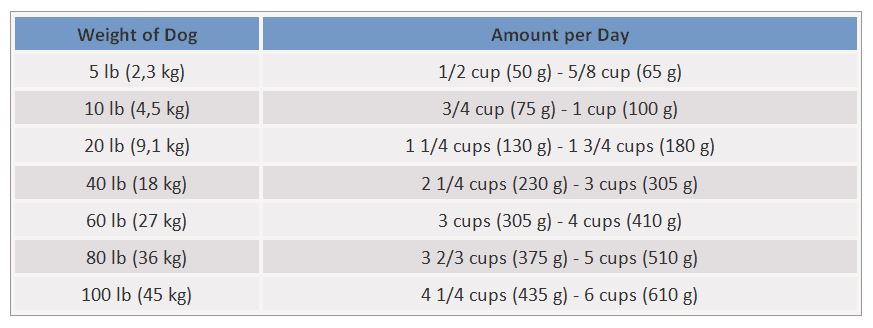
If you’re going to stick to any resolution, make sure it includes your pet! As 2017 commences, keep your dog in mind when thinking about your New Years Resolution!
Here are 10 New Years Resolution ideas involving your best friend!
-
Measure it out!

Not all dog food is made equally and not all dogs need the same amount of food. Not taking the time to properly measure out your dogs food can lead to over feeding and weight gain. Make sure you check the bag for recommended feeding guidelines or, if you can not find it, check out this chart for a good guideline for how much to feed Fido according to his weight. Remember that this is just a guideline and different dogs have different needs based on their age, activity level, and recommended weight. Growing pets have very specific nutrient requirements to ensure their bodies grow healthy and strong. some senior pets may have lower energy requirements, but have other medical issues like degenerative joint disease that may be helped with the appropriate diet. Choosing a diet specifically tailored to your pet’s life stage is a great way to keep them in optimal health. If still unsure, try asking your vet.
-
Stick to a healthy diet
Treats and snacks should only make up about 10% of your dog’d daily calorie intake. Your dog wants to look and feel their best as much as you want to. But dogs love treats and you love giving your dog treats! Try making a few adjustments to make your pet feel great! Doing simple things like cutting out table scraps and giving out one treat at a time can be very beneficial for your pets health.
Skip the store-bought snacks and try some fresh fruit and veggies. Carrots, green beans, broccoli, banana slices, berries, watermelon and apple slices are great choices. Watch out for grapes, raisins, onions, chocolate and anything with caffeine as these can harm your pet. -
Be More Active
Exercise is beneficial for not only yourself, but also your pet. From doga to hiking, taking a walk to playing tug of war or fetch, there are so many activities both indoor and outdoor, for your and your pet to participate in to stay healthy. Exercising is a great way to bond with your pet and both of you will benefit from the physical activity. Take a walk each day with your pooch, or spend some time playing around the house. It will increase your bond while integrating physical activity into both of your lives. Play also keeps your pets’ mind sharp; even just five minutes per day spent tossing a ball can mentally stimulate them! Try hosting a play date to help socialize your pet. Then your pet can get used to other people and animals while also benefiting from playtime.
-
Be More Social
While on the topic of socializing, it is very important that your dog be socialized. “Less socialized animals are typically fearful of normal situations,” says Cole Chavis, DVM, associate veterinarian at the Sangaree Animal Hospital in Summerville, SC. Behavior issues rank among the top reasons pets are surrendered to shelters as unsocialized dogs may cower, urinate submissively, bite, or hide. While socializing while your dog is a puppy is crucial, it is important that your dog stay social throughout its whole life. To help him socialize or make new friends, consider visiting your local dog park or scheduling a playdate with friendly neighborhood dogs. You may also make some new friends as well!
-
Learn some new tricks
Who says old dogs can’t learn new tricks! Studies show that mental stimulation can help reduce cognitive deterioration in aging animals. This means that keeping your dogs brain active can make them healthier! Try teaching your dog a new trick and practicing old tricks to keep their brains going. Practicing older tricks also helps reinforce obedience commands in dogs. Keep them mentally stimulated while you are not home with Puzzle feeders. These toys force your pet to think through a problem in order to receive a reward, or a treat.
-
Visit your vet
Just like humans, your pets need to visit the vet at least once per year., so while scheduling your yearly checkups, remember to schedule for your pet too! Many medical conditions such as diabetes, arthritis, or obesity are common in aging pets and much easier to manage when detected in the early stages of the disease process. Veterinary visits are also the perfect time to ask for advice, update your pet’s food, or get an expert opinion on any behavioral issues that may be affecting your bonding with your pet.
-
Groom more
Brushing your pet serves many purposes such as removing excess fur from the coat, distributing oils from the skin to the fur, and is bonding activity for you and your pet. You should attempt to brush your dog’s coat at least once a week, more is you have a long haired dog. Remove small knots by gently pulling at it, brushing away from the skin, to tease it apart. More stubborn knots may need to be cut out, but be very careful. After walks, look for burrs, leaves, and seeds that might have lodged in your dog’s coat and remove them to prevent the formation of mats.
Also, remember to take your pet to the groomers for a fresh haircut!
-
Practice good oral hygiene
Daily toothbrushing is the best way to keep tarter and plaque away for both your pet and yourself. When brushing your pets teeth, make sure you are using a toothpaste that is meant for them. While dogs don’t consume many of the cavity-causing foods that humans do, they still benefit from regular oral care for many of the same reasons that we do. Did you know that by the time your pup is three, they will most likely already be showing signs of gum disease? And your pet will not show pain from dental disease, but if the problem worsens, the process of losing teeth can be very painful. Plus, healthy teeth equals healthy breath. And no one likes smelly dog breath.
-
Update your tags
A lot can change over a year. People moving, getting new phone numbers. While going over all the new information you and your family has changed over the year, make sure your pet is also up to date. Check their tags to make sure athe information on them is current. If your dog has a microchip, make sure that is up to date too. Don’t wait until your best friend is lost to remember to update your tags.
-
Get a new best friend
You can’t always be home all the time and, though you may not think about it, your dog might get lonely. You think you want a new pet, but you’re not 100 percent sure it’s right for you? Try fostering. Many animal shelters and rescues need loving homes to provide safe and temporary living arrangements for pets. It’s the perfect way to test the waters of pet ownership without the lifelong commitment, since you are simply hosting a pet while they wait for their forever home. This way, your pet will have company for while you are not home and the new dog will get valuable social experience. Just make sure you watch the two dogs for the first few days or maybe ease the new dog into to make sure the new dog is acclimating ok to their new surroundings.




